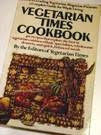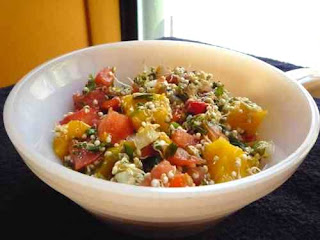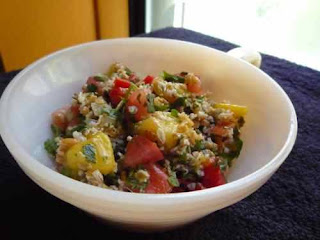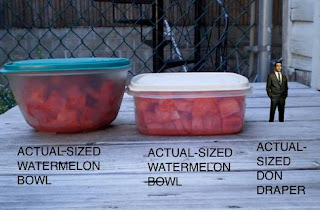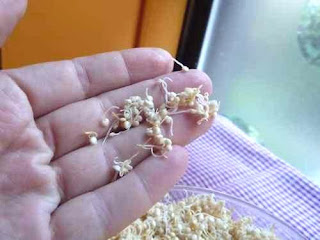Every Saturday, we post a piece from the CHG archives. This one comes from March 2008, and includes then-timely Elliot Spitzer and J.D. Salinger-being-alive references. Oh, Comedy. You are a cruel mistress.
If you’ve been to the supermarket in the last few months, the rising cost of food isn’t exactly an Elliot Spitzer-level surprise. Grain prices are up, dairy products have become a luxury, and meat … well, cheap beef is rarer than a J.D. Salinger sighting these days. CNN, MSNBC, and the newspapers are finally picking up on it, too, with more stories about global grocery shortages and ludicrous shipping expenses. It appears we’re headed for a recession, and it may not get better anytime soon.
 Never fear, though – it’s the interweb to the rescue. Lots of wonderfully informed bloggers have been totally on the ball, including Cathy at Chief Family Officer and Blogher’s Alanna Kellogg. They’ve written stellar pieces on combating food inflation, replete with shopping strategies, cooking ideas, and inventive ideas for stretching a budget.
Never fear, though – it’s the interweb to the rescue. Lots of wonderfully informed bloggers have been totally on the ball, including Cathy at Chief Family Officer and Blogher’s Alanna Kellogg. They’ve written stellar pieces on combating food inflation, replete with shopping strategies, cooking ideas, and inventive ideas for stretching a budget.There’s not much more to say after those posts, but I figured I’d jump on the Food/Recession bandwagon anyway. (It’s a nice bandwagon – sage green with mammoth cupholders.) Hopefully, the following suggestions will build on what Cathy and Alanna have to say, and offer a few new strategies along with it.
Don’t panic. It’s not the end of the world. Grocery prices will rise and certain items may become nigh-unattainable, but you will still be able to eat. So will your family. And with a little planning, you might not notice much of a difference.
Stay informed. Information is power. I don’t know who said that (Sophocles? Joan Didion? Cher?), but he/she was right on. As dire as the news may seem sometimes, keeping abreast of the fiscal situation is vital to preparing for sudden changes. So gird your loins and peruse the news, scan some blogs, and watch the occasional Brian Williams broadcast. Be on special lookout for food stories. You’ll be smarter for it.
Take baby steps. Revamping your diet and budget the same day won’t work, and might put you off both forever. Lasting change comes through small actions executed consistently. so take it easy. Start small, with a few simple practices, and work your way up from there.
 Set aside one hour per week to plan. During this hour, you can devise a weekly menu, find circular deals online, clip coupons, and map out your shopping trips, all of which could save hundreds of dollars a month. If you were paid $100 for 60 minutes of work, wouldn’t you do it? Would you think twice? (Lawyers and doctors, don’t answer that.) What’s more, it’s much easier to stay on a healthy track when you have a concrete shopping and meal plans. It keeps you from scrounging for last-minute eats.
Set aside one hour per week to plan. During this hour, you can devise a weekly menu, find circular deals online, clip coupons, and map out your shopping trips, all of which could save hundreds of dollars a month. If you were paid $100 for 60 minutes of work, wouldn’t you do it? Would you think twice? (Lawyers and doctors, don’t answer that.) What’s more, it’s much easier to stay on a healthy track when you have a concrete shopping and meal plans. It keeps you from scrounging for last-minute eats.Write stuff down. Keeping a budget, planning that menu, and creating a grocery list are three time-tested, mother-approved money-saving maneuvers. The last two strategies usually help with weight maintenance, as well. Turns out, there is no greater splurging/gorging deterrent than knowing exactly what you’re splurging/gorging on.
Sign up for savings and preferred customer cards. If you haven’t already done this, stop reading and run to your grocer. See, just about every major supermarket has a club program that offers special discounts to regular shoppers. You give them your name and e-mail address in exchange for a dinky little keychain doohickey that magically saves 10%, 20%, or 40% per purchase. As far as I know, there are no reported downsides, except for a very heavy keychain.
Start a price book post haste. Get Rich Slowly has the end-all-be-all post on these, but there’s more at Frugal Upstate, as well as a downloadable template at No Credit Needed. (Incidentally, if you’re in the New York City area and shop at Associated or Key Food, shoot me an e-mail. I keep somewhat anarchic pricebooks for these two stores, and can forward them to you.)
Go to Money Saving Mom immediately. I can’t possibly cover this topic any better than Crystal does on a daily basis. (Brown nosing? Yes. And how!) Essentially, she and a roving gang of coupon-clippin’ ladybloggers have figured out how to score deeply discounted personal effects and non-perishable food from CVS, Walgreens, Rite Aid, and more. We’re talking $133 worth of shampoo, diapers, and toothpaste for $9. And if that’s not enough, there are shopping strategies GALORE, from post to shining post.
When it comes to cookbooks and kitchen equipment, buy only what you absolutely need. If cooking is a hobby, it’s distressingly easy to blow a wad on adorable egg holders. Or a fourth Barefoot Contessa volume. Or a hard-anodized 10-piece pot set, because some dude on QVC said you SIMPLY MUST HAVE a sauté pan in every size. Truth is, there are precious few items anyone needs to make a decent meal, and most recipes can be found online nowadays. This Mark Bittman article has more, and these two CHG posts can help you find inexpensive equipment and cookbooks.
Clip coupons and bulk shop, but do it wisely. While both of these tactics might take big bucks off bills, they can also lull folks into buying stuff they don’t need. If you’re going to use coupons, make sure it’s for something you would purchase anyway. And if you’re loading that 128-oz. jar of capers into your elephant-sized CostCo cart, double check to see if it’s really cheaper per unit than a 4-oz. bottle. (While you’re at it, double check to see who on Earth needs eight pounds of capers.)
Cut back on booze, meat, and processed foods. “But Kris,” you might say,“they are the stuff OF LIFE.” And you’d totally be correct. Watching a ballgame without a dirty water dog and bucket-sized Bud Light … it’s unfathomable for some. (Note: me.) However, there’s something to be said for moderation. Eliminating these things from your diet entirely may be a pipe dream (or pipe nightmare), but reducing your consumption will save mad cash AND improve your health. To fill that hole in your stomach …
 Eat real food. Pizza rolls, mozzarella sticks, and fries might be convenient, but produce, dairy, meat, legumes, and grain will help you live longer. AND, chosen carefully, they’ll cost less in the long run. Always remember to shop in season, from the circular, and around the perimeter of the supermarket, where they keep the whole foods.
Eat real food. Pizza rolls, mozzarella sticks, and fries might be convenient, but produce, dairy, meat, legumes, and grain will help you live longer. AND, chosen carefully, they’ll cost less in the long run. Always remember to shop in season, from the circular, and around the perimeter of the supermarket, where they keep the whole foods.Stock up. When frequently-used staple items like flour, beans, and canned tomatoes go on mega-sale, snatch up as much as you possibly can (provided there’s sufficient storage). Not only will they come in handy down the line, but pantry meals can be healthy, filling, and surprisingly delicious. For more information, Motherload’s Amy Clark has an ongoing series on stockpiling.
Go generic. Don't be scared. It's often just as good as the brand name.
D.I.Y. Cook more at home. Cook in bulk. Freeze things. Try gardening. Make your own mixes, dressings, sauces, and marinades. (They taste better, take zero culinary skill, and cost a fraction of the store-bought brands.) With a little time and effort, anything you see in the supermarket or at a restaurant can be accomplished in your own kitchen.
Drink water, but not the bottled kind. No one’s begrudging the occasional Dr. Pepper, but tap water is the superior choice for two reasons: it’s a billion times healthier and 100%, totally, absolutely free-er than free. Bottled water, while not a terrible choice, is a legendary rip-off, like bad chicken or accidentally downloading a Beatles cover band on iTunes.
Brown bag it. Any and every personal finance blog worth its salt has written about this subject 600 times (uh … except this one.), and for good reason. Not only does brown-bagging save me about $1300 per year, but it makes it much, MUCH (much) easier to monitor what I eat. Whether you’re into bento boxes or PB&J, it’s a sure-fire recession beater.
Think out of the box. No, DESTROY the box. Stupid box. There’s no faster way to bore yourself into a coma than gnawing on the same ol’ lettuce wrap week after week. To save money and keep from dying of ennui, leave your comfort zone as often as possible. Try new foods. Experiment with coupons. Cook differently. Host a potluck. Visit your ethnic market. Stepping outside the norm can inspire AND help you stick to the plan.
Don’t panic. Had to be said again.
If you're interested in reading further, these are solid sources:
- Drastic Budgeting in the Kitchen at The Common Room
- 50 Ways to Save Money on Your Grocery Bill at Thrifty Mommy
- Supermarket Strategies at Real Simple
- Debt Diet for Your Wallet and Your Waistline at Debt Hater
- Hillbilly Housewife
How about y’all out there? How are you preparing for a potential economic downturn? Comments are open!
(Photos courtesy of jupiter images, Watt & Sons Supermarket, and Flickr member Ranjit.)
(Photos courtesy of jupiter images, Watt & Sons Supermarket, and Flickr member Ranjit.)


